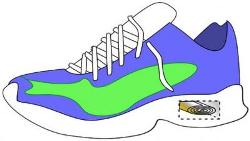Apr 28 2010
Dr. Ville Kaajakari, assistant professor of electrical engineering at Louisiana Tech University, is being featured by MEMS Investor Journal, a national online industry publication, for developing a technology that harvests power from a small generator embedded in the sole of a shoe.
 This is Dr. Ville Kaajakari's, Louisiana Tech University, shoe power generator.
This is Dr. Ville Kaajakari's, Louisiana Tech University, shoe power generator.
MEMS are tiny "smart" devices that combine computer chips with micro-components such as sensors, gears, flow-channels, mirrors and actuators.
Kaajakari's innovative technology, developed at Louisiana Tech's Institute for Micromanufacturing (IfM), is based on new voltage regulation circuits that efficiently convert a piezoelectric charge into usable voltage for charging batteries or for directly powering electronics.
"This technology could benefit, for example, hikers that need emergency location devices or beacons," said Kaajakari. "For more general use, you can use it to power portable devices without wasteful batteries."
MEMS Investor Journal is an independent publication that provides investment professionals with the latest developments in the micro electro mechanical systems (MEMS) industry.
According to the article, energy harvesting is an attractive way to power MEMS sensors and locator devices such as GPS. However, power harvesting technologies often fall short in terms of output as many of today's applications require higher power levels.
Kaajakari's breakthrough uses a low-cost polymer transducer that has metalized surfaces for electrical contact. Unlike conventional ceramic transducers, the polymer-based generator is soft and robust, matching the properties of regular shoe fillings. The transducer can therefore replace the regular heel shock absorber with no loss in user experience.
In addition to running sensors and inertial navigation, Kaajakari's shoe power generator can also be used to power RF transponders and GPS receivers.
"Ultimately, we want to bring up the power levels up to a point where we could, in addition to sensors, charge or power other portable devices such as cell phones."
Source: http://www.latech.edu/